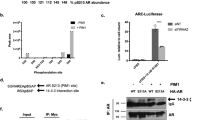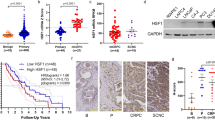Abstract
We have previously shown that protein kinase D1 (PKD1), charter member of PKD protein family, is downregulated in advanced prostate cancer (PC) and influences androgen receptor (AR) function in PC cells. Other independent studies showed that serine 82 residue in heat shock protein 27 (Hsp27) undergoes substrate phosphorylation by PKD1 and is associated with nuclear transport of AR resulting in increased AR transcriptional activity. In this study, we show that PKD1 interacts and phosphorylates Hsp27 at Ser82 in PC cells, which is mediated by p38-dependent mitogen-activated protein kinase pathway and is necessary for PKD1 repression of AR transcriptional activity and androgen-dependent proliferation of PC cells. The study provides first in vivo evidence that Hsp27 is a mediator of repression of AR function by PKD1 in PC cells, thereby linking the data in the published literature.
This is a preview of subscription content, access via your institution
Access options
Subscribe to this journal
Receive 50 print issues and online access
$259.00 per year
only $5.18 per issue
Buy this article
- Purchase on Springer Link
- Instant access to full article PDF
Prices may be subject to local taxes which are calculated during checkout






Similar content being viewed by others
References
Belka C, Ahlers A, Sott C, Gaestel M, Herrmann F, Brach MA . (1995). Interleukin (IL)-6 signaling leads to phosphorylation of the small heat shock protein (Hsp)27 through activation of the MAP kinase and MAPKAP kinase 2 pathway in monocytes and monocytic leukemia cells. Leukemia 9: 288–294.
Carraway R, Leeman SE . (1976). Characterization of radioimmunoassayable neurotensin in the rat. Its differential distribution in the central nervous system, small intestine, and stomach. J Biol Chem 251: 7045–7052.
Carraway RE, Hassan S . (2007). Neurotensin receptor binding and neurotensin-induced growth signaling in prostate cancer PC3 cells are sensitive to metabolic stress. Regul Pept 141: 140–153.
Cornford PA, Dodson AR, Parsons KF, Desmond AD, Woolfenden A, Fordham M et al. (2000). Heat shock protein expression independently predicts clinical outcome in prostate cancer. Cancer Res 60: 7099–7105.
Doppler H, Storz P, Li J, Comb MJ, Toker A . (2005). A phosphorylation state-specific antibody recognizes Hsp27, a novel substrate of protein kinase D. J Biol Chem 280: 15013–15019.
Du C, Ge B, Liu Z, Fu K, Chan WC, McKeithan TW . (2006). PCR-based generation of shRNA libraries from cDNAs. BMC Biotechnol 6: 28.
Du C, Jaggi M, Zhang C, Balaji KC . (2009). Protein kinase D1-mediated phosphorylation and subcellular localization of beta-catenin. Cancer Res 69: 1117–1124.
Dudich IV, Zav′yalov VP, Pfeil W, Gaestel M, Zav′yalova GA, Denesyuk AI et al. (1995). Dimer structure as a minimum cooperative subunit of small heat-shock proteins. Biochim Biophys Acta 1253: 163–168.
Edwards J, Bartlett JM . (2005). The androgen receptor and signal-transduction pathways in hormone-refractory prostate cancer. Part 2: androgen-receptor cofactors and bypass pathways. BJU Int 95: 1327–1335.
Evans IM, Britton G, Zachary IC . (2008). Vascular endothelial growth factor induces heat shock protein (HSP) 27 serine 82 phosphorylation and endothelial tubulogenesis via protein kinase D and independent of p38 kinase. Cell Signal 20: 1375–1384.
Fanelli MA, Montt-Guevara M, Diblasi AM, Gago FE, Tello O, Cuello-Carrion FD et al. (2008). P-cadherin and beta-catenin are useful prognostic markers in breast cancer patients; beta-catenin interacts with heat shock protein Hsp27. Cell Stress Chaperones 13: 207–220.
Geum D, Son GH, Kim K . (2002). Phosphorylation-dependent cellular localization and thermoprotective role of heat shock protein 25 in hippocampal progenitor cells. J Biol Chem 277: 19913–19921.
Gomase VS, Tagore S . (2008). Kinomics. Curr Drug Metab 9: 255–258.
Haslbeck M, Buchner J . (2002). Chaperone function of sHsps. Prog Mol Subcell Biol 28: 37–59.
Jaggi M, Chauhan SC, Du C, Balaji KC . (2008). Bryostatin 1 modulates beta-catenin subcellular localization and transcription activity through protein kinase D1 activation. Mol Cancer Ther 7: 2703–2712.
Jaggi M, Du C, Zhang W, Balaji KC . (2007). Protein kinase D1: a protein of emerging translational interest. Front Biosci 12: 3757–3767.
Jaggi M, Rao PS, Smith DJ, Hemstreet GP, Balaji KC . (2003). Protein kinase C mu is down-regulated in androgen-independent prostate cancer. Biochem Biophys Res Commun 307: 254–260.
Jaggi M, Rao PS, Smith DJ, Wheelock MJ, Johnson KR, Hemstreet GP et al. (2005). E-cadherin phosphorylation by protein kinase D1/protein kinase C{mu} is associated with altered cellular aggregation and motility in prostate cancer. Cancer Res 65: 483–492.
Ku GY, Ilson DH, Schwartz LH, Capanu M, O′Reilly E, Shah MA et al. (2008). Phase II trial of sequential paclitaxel and 1 h infusion of bryostatin-1 in patients with advanced esophageal cancer. Cancer Chemother Pharmacol 62: 875–880.
Lee LF, Guan J, Qiu Y, Kung HJ . (2001). Neuropeptide-induced androgen independence in prostate cancer cells: roles of nonreceptor tyrosine kinases Etk/Bmx, Src, and focal adhesion kinase. Mol Cell Biol 21: 8385–8397.
Li J, Chen LA, Townsend Jr CM, Evers BM . (2008). PKD1, PKD2, and their substrate Kidins220 regulate neurotensin secretion in the BON human endocrine cell line. J Biol Chem 283: 2614–2621.
Maizels ET, Peters CA, Kline M, Cutler Jr RE, Shanmugam M, Hunzicker-Dunn M . (1998). Heat-shock protein-25/27 phosphorylation by the delta isoform of protein kinase C. Biochem J 332 (Pt 3): 703–712.
Mak P, Jaggi M, Syed V, Chauhan SC, Hassan S, Biswas H et al. (2008). Protein kinase D1 (PKD1) influences androgen receptor (AR) function in prostate cancer cells. Biochem Biophys Res Commun 373: 618–623.
Manning G, Whyte DB, Martinez R, Hunter T, Sudarsanam S . (2002). The protein kinase complement of the human genome. Science 298: 1912–1934.
Martinez V, Tache Y . (2000). Bombesin and the brain-gut axis. Peptides 21: 1617–1625.
Moody TW, Chan D, Fahrenkrug J, Jensen RT . (2003). Neuropeptides as autocrine growth factors in cancer cells. Curr Pharm Des 9: 495–509.
Mosca A, Berruti A, Russo L, Torta M, Dogliotti L . (2005). The neuroendocrine phenotype in prostate cancer: basic and clinical aspects. J Endocrinol Invest 28: 141–145.
Neckers L . (2003). Development of small molecule Hsp90 inhibitors: utilizing both forward and reverse chemical genomics for drug identification. Curr Med Chem 10: 733–739.
Parcellier A, Schmitt E, Gurbuxani S, Seigneurin-Berny D, Pance A, Chantome A et al. (2003). HSP27 is a ubiquitin-binding protein involved in I-kappaBalpha proteasomal degradation. Mol Cell Biol 23: 5790–5802.
Roberts JD, Smith MR, Feldman EJ, Cragg L, Millenson MM, Roboz GJ et al. (2006). Phase I study of bryostatin 1 and fludarabine in patients with chronic lymphocytic leukemia and indolent (non-Hodgkin′s) lymphoma. Clin Cancer Res 12: 5809–5816.
Rocchi P, Beraldi E, Ettinger S, Fazli L, Vessella RL, Nelson C et al. (2005). Increased Hsp27 after androgen ablation facilitates androgen-independent progression in prostate cancer via signal transducers and activators of transcription 3-mediated suppression of apoptosis. Cancer Res 65: 11083–11093.
Rocchi P, Jugpal P, So A, Sinneman S, Ettinger S, Fazli L et al. (2006). Small interference RNA targeting heat-shock protein 27 inhibits the growth of prostatic cell lines and induces apoptosis via caspase-3 activation in vitro. BJU Int 98: 1082–1089.
Rocchi P, So A, Kojima S, Signaevsky M, Beraldi E, Fazli L et al. (2004). Heat shock protein 27 increases after androgen ablation and plays a cytoprotective role in hormone-refractory prostate cancer. Cancer Res 64: 6595–6602.
Rouse J, Cohen P, Trigon S, Morange M, Alonso-Llamazares A, Zamanillo D et al. (1994). A novel kinase cascade triggered by stress and heat shock that stimulates MAPKAP kinase-2 and phosphorylation of the small heat shock proteins. Cell 78: 1027–1037.
Rozengurt E, Rey O, Waldron RT . (2005). Protein kinase D signaling. J Biol Chem 280: 13205–13208.
Rybin VO, Guo J, Steinberg SF . (2009). Protein kinase D1 autophosphorylation via distinct mechanisms at Ser744/Ser748 and Ser916. J Biol Chem 284: 2332–2343.
Simental JA, Sar M, Lane MV, French FS, Wilson EM . (1991). Transcriptional activation and nuclear targeting signals of the human androgen receptor. J Biol Chem 266: 510–518.
So A, Hadaschik B, Sowery R, Gleave M . (2007). The role of stress proteins in prostate cancer. Curr Genomics 8: 252–261.
Stokoe D, Engel K, Campbell DG, Cohen P, Gaestel M . (1992). Identification of MAPKAP kinase 2 as a major enzyme responsible for the phosphorylation of the small mammalian heat shock proteins. FEBS Lett 313: 307–313.
Syed V, Mak P, Du C, Balaji KC . (2008). Beta-catenin mediates alteration in cell proliferation, motility and invasion of prostate cancer cells by differential expression of E-cadherin and protein kinase D1. J Cell Biochem 104: 82–95.
Valverde AM, Sinnett-Smith J, Van Lint J, Rozengurt E . (1994). Molecular cloning and characterization of protein kinase D: a target for diacylglycerol and phorbol esters with a distinctive catalytic domain. Proc Natl Acad Sci USA 91: 8572–8576.
Wang G, Wang J, Sadar MD . (2008). Crosstalk between the androgen receptor and beta-catenin in castrate-resistant prostate cancer. Cancer Res 68: 9918–9927.
Wang QJ . (2006). PKD at the crossroads of DAG and PKC signaling. Trends Pharmacol Sci 27: 317–323.
Widmann C, Gibson S, Jarpe MB, Johnson GL . (1999). Mitogen-activated protein kinase: conservation of a three-kinase module from yeast to human. Physiol Rev 79: 143–180.
Yuan J, Rozengurt E . (2008). PKD, PKD2, and p38 MAPK mediate Hsp27 serine-82 phosphorylation induced by neurotensin in pancreatic cancer PANC-1 cells. J Cell Biochem 103: 648–662.
Zoubeidi A, Zardan A, Beraldi E, Fazli L, Sowery R, Rennie P et al. (2007). Cooperative interactions between androgen receptor (AR) and heat-shock protein 27 facilitate AR transcriptional activity. Cancer Res 67: 10455–10465.
Acknowledgements
We thank Dr FJ Johannes, Fraunhofer Institute for Interfacial Engineering, Stuttgart, Germany for providing the PKD1 expression vector. This study was supported by an institutional grant from the Department of Surgery, University of Massachusetts Medical School.
Author information
Authors and Affiliations
Corresponding author
Rights and permissions
About this article
Cite this article
Hassan, S., Biswas, M., Zhang, C. et al. Heat shock protein 27 mediates repression of androgen receptor function by protein kinase D1 in prostate cancer cells. Oncogene 28, 4386–4396 (2009). https://doi.org/10.1038/onc.2009.291
Received:
Revised:
Accepted:
Published:
Issue Date:
DOI: https://doi.org/10.1038/onc.2009.291
Keywords
This article is cited by
-
FYN/TOPK/HSPB1 axis facilitates the proliferation and metastasis of gastric cancer
Journal of Experimental & Clinical Cancer Research (2023)
-
Androgen receptor and heat shock protein 27 co-regulate the malignant potential of molecular apocrine breast cancer
Journal of Experimental & Clinical Cancer Research (2018)
-
In vitro cytotoxicity, pharmacokinetics, tissue distribution, and metabolism of small-molecule protein kinase D inhibitors, kb-NB142-70 and kb-NB165-09, in mice bearing human cancer xenografts
Cancer Chemotherapy and Pharmacology (2013)
-
Effect of the heat shock protein HSP27 on androgen receptor expression and function in prostate cancer cells
World Journal of Urology (2012)



